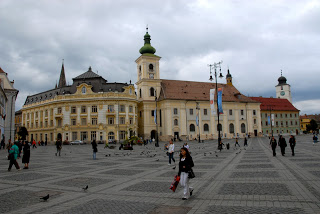
Pia?a Mare, the largest square in Sibiu. Called “Der Grosse Ring”when Lisi, my grandmother, worked here for Mrs. Jickeli
Travel Tuesday
In two previous Travel Tuesday posts, I wrote about my brothers and my visit to the small museum at the back of my grandfather Josef’ Gartz’s Neppendorf church, where we were astounded to find copies of our very own family photos representing daily life in Josef’s home town (Spilling Secrets), as well as photos of our famous bandleader cousin, Michael Gärtz. After the church, our next stop was the “big city” of Hermannstadt (“Hermann’s City,”) founded by Hermann of Nuremburg in 1150), just a few kilometers distant from Neppendorf. It’s called Sibiu by the Romanians; Nagyszében by the Hungarians. A beautiful medieval town, it is one of the “seven fortresses,” or walled cities, that make up the area of Siebenbürgen/Transylvania. It is also the city where my grandmother, Lisi, worked for Mrs. Jickeli, whose family owned a successful hardware store on what was then called “Der Grosse Ring,” the Great Ring, but has been renamed Pia?a Mare, one of Sibiu’s three main squares.
For centuries, Sibiu was one of the most important towns in Saxon Land. It’s been declared a Unesco World Heritage Site and the year we visited in 2007, had been chosen as European Capital of Culture. Sibiu’s old town comprises three recently re-cobbled squares called Pia?as (pronounced “piazza”– the Romanian language is very similar to Latin). In fact, just about every town we visited in Romania, major infrastructure improvements were underway, old cobbles being torn up and replaced to update underground sewers. It was a country trying to catch up.
In Sibiu, the Evangelical Lutheran Cathedral. with its pointed spire soaring up to seventy meters, dominates one of the smaller squares, Pia?a Huet. Surrounding the main tower are four shorter turrets. Just like my grandfather’s church in Neppendorf, this one had also been originally Catholic until the Reformation.
The church is a beautiful, soaring Gothic structure built between 1300 and 1520. Even the notorious Vlad the Impaler (see post, The Real Dracula) has a representative of his family entombed in this church: his son, Mihnea Vod? cel Ru? (Prince Mihnea the Bad–is that moniker any surprise?). He’s in a closed- off section behind the organ. We didn’t ask for entry, but visitors can.
Besides its peaceful light-filled ambience, a highlight of the interior is a superbly restored gigantic fresco (over nine meters high) painted in 1445 by Johannes of Rosenau. Outside the entrance stands a statue bronze statue in tribute to the renowned Bishop, Georg Teutsch, a strong advocate for Transylvanian Saxon culture.
Sibiu is a joy to walk. Sleepy eyelid windows peek out from rooftops, as we walked past pastel-painted, single-story homes nestled together on side streets or down ancient, cobbled narrow byways. Southwest from Pia?a Huet and the Lutheran Church on Str Mitropoliei stands the 1906 Orthodox Cathedral, a smaller version of Istanbul’s Hagia Sofia. We saw orthodox priests in their distinctive black robes and hats conversing on the sidewalk in front, a sign of the city’s diverse histories.
But for me, the stand-out feature was the city walls, the existence of which lends the name Siebenbürgen (seven fortresses) to Sibiu and its six other Saxon-land counterparts. These imposing stone walls, interspersed with 39 towers up to sixty-four meters high, encircle the town, a bulwark critical in centuries past to shield its wealth from Turkish attacks. It still stands as a physical reminder of the constant state of vigilance under which the Saxon Germans had to live.
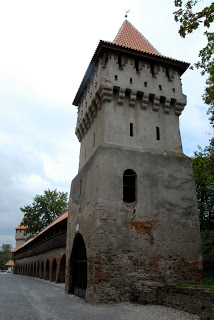
“Potters’ Tower.” Each tower in the wall guarding Sibiu was named after and maintained by a different guild.
Just as Sibiu protected its Saxon inhabitants from invaders for hundreds of years, the city now guards the Siebenbürgen German’s history for future generations. In the next Travel Tuesday post, we’ll visit the historical archives of the Transylvanian Saxons, where an ancient ledger held the key to finding my grandmother, Lisi’s, home in nearby Grosspold.
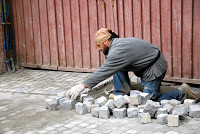
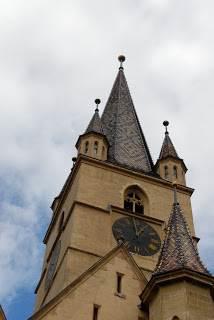
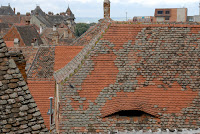
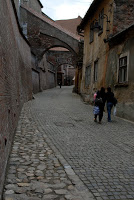
Linda – I nominated you for the One Lovely Blog award. I enjoy your writing style and the photos that you have included in your blog.
Kind regards,
Cindy Harris
GenerationsOfGermans.blogspot.com
MySavages.blogspot.com
Linda,
I cannot believe how charming this town is. I would love to visit there. Despite trying to “catch up” with the 21st Century, it still has a wonderful 19th century feel to it. Also, congratulations on your nomination for the One Lovely Blog Award.
Thank you, Cindy, for considering me for the One Lovely Blog Award. I will do my best to pass on! And Kathy… yes, the town is really fun to walk — a sense you’ve been transported centuries into the past.
Linda,
Once again your graphics are terrific. Sibiu is a beautiful place and I read that it’s the most culturally active of the Transylvanian Saxon towns. It looks as the EU made a good choice when they designated it the ‘Capital of Culture’ for 2007. Those eyelid windows must be unique and your description of pastel colored buildings provides clear images of a place worth visiting.
Sandy, thanks for a welcome comment. I always enjoy your attention to the details of my posts!